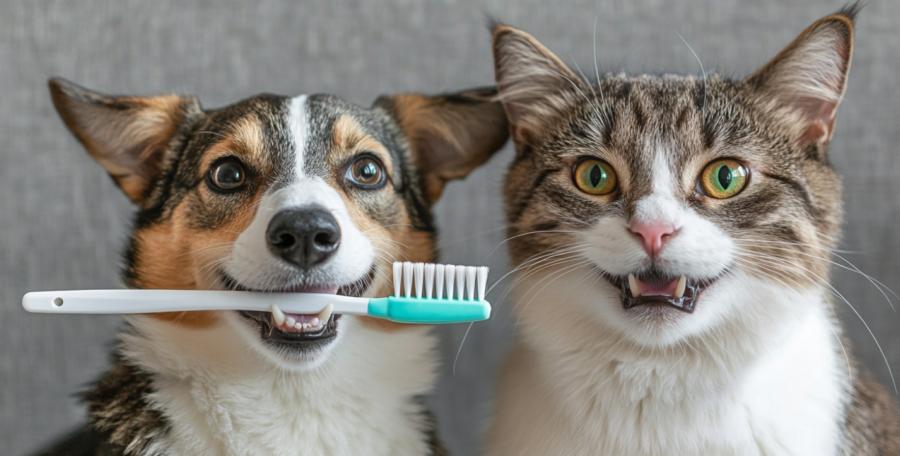When we think about preventing illness, dental issues may not appear at the top of the list, yet they are among the most common health concerns for cats and dogs. Gum inflammation, plaque buildup and hidden infections can creep in quietly. Pets are experts at pretending everything’s fine—right up until it isn’t. That’s why a proactive approach pays off, even if your pet considers dental care an outrageous personal insult.
Understanding What’s Going On in That Mouth
Your dog might grin like a mischievous toddler who’s stolen a biscuit, but behind the smile could be early signs of periodontal trouble. Cats, on the other hand, often play it cool, masking discomfort with a dignified air. Beneath that composure, tartar may be quietly settling in like an uninvited long-term tenant. Left alone, these issues can lead to pain, infection or even affect the heart and kidneys. That’s a steep price for neglecting a brushing routine.Some pets are genetically predisposed to dental troubles. Small-breed dogs seem particularly determined to grow tiny, troublesome teeth that require more attention. Meanwhile, certain cats experience resorptive lesions—painful problems that sound like something from a gothic novel but are very real. Understanding these risks helps you prepare rather than panic.
Brushing Without the Drama
To a pet, a toothbrush might look like an alien probe. Still, introducing brushing slowly can prevent theatrics. Let them sniff the brush first, then try a small dab of pet-safe toothpaste. Chicken-flavored toothpaste exists, which feels slightly absurd, but if it encourages cooperation, so be it. Begin with brief sessions, celebrate tiny victories and avoid turning it into a wrestling match. No creature performs their best when trapped in a headlock, human or otherwise.Even with patience, some pets never fully embrace brushing. That’s fine—routine attempts still reduce plaque and make future dental checks easier. Over time, most animals accept the ritual with the weary resignation of someone agreeing to floss after their dentist gives *that* look.
Helpful Tools Beyond the Toothbrush
Dental care doesn’t need to hinge on brushing alone. There are plenty of supportive options that slip neatly into a daily routine. Many of them feel almost like treats, which your pet may interpret as evidence that you’ve finally come to your senses. Useful additions include:- Dental chews that help reduce plaque while giving pets something satisfying to gnaw on
- Specially formulated diets that encourage cleaner teeth through controlled texture and ingredients
- Water additives that freshen breath and support oral hygiene with minimal fuss
Why Regular Dental Check-Ups Matter
Even with a solid at-home routine, professional dental checks are essential. Vets can spot issues that hide under the surface, long before your pet shows discomfort. Animals often endure oral pain silently, not out of stoicism but because they don’t realise anyone can help. A trained eye can detect early gum disease, fractured teeth, or infections that would otherwise simmer unnoticed.These appointments sometimes require sedation for a full cleaning, which sounds dramatic but allows a thorough and painless approach. It’s far better than letting problems progress to extractions or chronic pain. Preventive check-ups cost less in the long run and spare your pet from avoidable suffering.
Diet’s Quiet Influence on Dental Health
What your pet eats shapes more than their waistline. Dry foods can help reduce plaque by providing natural abrasion, though not all kibble is created equal. Some diets are specifically designed to promote oral health, while others crumble too easily to offer meaningful benefit. Wet foods, though often beloved, can stick to teeth and may require more frequent cleaning efforts.Treats also play a part. Crunchy, dental-friendly options are helpful, but sugary or sticky snacks—yes, even the supposedly “wholesome” ones—can undermine your efforts. Moderation and label-reading go a long way. Your pet will still think you’re the benevolent provider of goodies; they don’t need to know you’re making strategic health decisions.
Daily Habits That Make a Long-Term Difference
Small, consistent actions accumulate into real benefits. A few minutes spent checking your pet’s mouth each week becomes second nature. Look for redness, swelling, unusual smells, or any reluctance to chew. These signs don’t always mean catastrophe, but they’re worth noting. Early detection is your greatest ally, even if your pet insists they’re absolutely fine and would rather you stopped prying.Building dental care into regular routines also strengthens trust. Pets appreciate predictability, and while no amount of routine will make every cat volunteer for brushing duty, they do recognise care when they experience it—occasionally in the form of suspicious squinting, but still appreciation in its own way.
Biting Into the Bigger Picture
Healthy teeth and gums support whole-body wellness. Oral bacteria can travel through the bloodstream, affecting vital organs. That’s not meant to alarm, but to emphasise the value of preventive care. A bit of daily attention can spare your pet from long-term complications. Plus, fewer dental problems mean fresher breath, which is a victory for anyone who frequently receives affectionate but pungent face-licks.Pets rely on us to notice what they can’t articulate. Giving their oral health steady care respects that bond and improves their quality of life. It’s an investment that pays off in comfort, longevity and far fewer surprise expenses.
A Punny Send-Off: Chews Wisely
Tending to your pet’s teeth doesn’t demand perfection—just consistency, patience and a willingness to navigate the occasional toothpaste-splattered moment. With simple tools, mindful habits and regular check-ups, you set the foundation for a healthier mouth and a happier companion. Their grin becomes brighter, their breath less intimidating and their overall wellbeing stronger. A little effort goes a long way when you decide to truly *chews* wisely.Article kindly provided by ironstonevetclinic.co.uk

